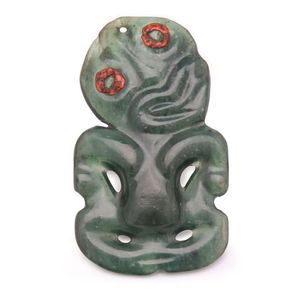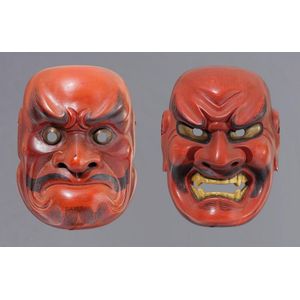Meiji/Taisho Wood Noh Masks: Beshimi and Rashomon
You must be a subscriber, and be logged in to view price and dealer details.
Subscribe Now to view actual auction price for this item
When you subscribe, you have the option of setting the currency in which to display prices to $Au, $US, $NZ or Stg.
- Gilding - Gilding is a method of ornamentation whereby a thin sheet of gold metal is applied to items made of wood, leather, ceramics, glass and silver for decorative purposes.
For furniture including mirrors, the sheet of gold is usually applied over a coating of gesso. Gesso is a mixture of plaster of Paris and gypsum mixed with water and then applied to the carved wooden frames of mirrors and picture frames as a base for applying the gold leaf. After numerous coats of gesso have been applied, allowed to dry and then sanded a coat of "bole", a usually red coloured mixture of clay and glue is brushed on and allowed to dry, after which the gold leaf is applied. Over time parts of the gilding will rub off so the base colour can be seen. In water gilding, this was generally a blue colour, while in oil gilding, the under layer was often yellow. In Victorian times, gilders frequently used red as a pigment beneath the gold leaf.
Metal was often gilded by a process known as fire gilding. Gold mixed with mercury was applied and heated, causing the mercury to evaporate, the long-term effect of which was to kill or disable the craftsman or woman from mercury poisoning. The pursuit of beauty has claimed many victims, not the least of which were the artists who made those pieces so highly sought after today. - Incised - A record of a name, date or inscription, or a decoration scratched into a surface, usually of a glass or ceramic item with a blunt instrument to make a coarse indentation. Compare with engraving where the surface is cut with a sharp instrument such as a metal needle or rotating tool to achieve a fine indentation.
This item has been included into following indexes:
Visually similar items

A good quality 19th century greenstone tiki, with hourglass hole and red wax eyes. Length 10 cm. Width 6 cm

A Japanese red lacquer noh mask of Jinta-Men, Edo period, circa 18th century, Carved in wood, painted with red, gilt and brown lacquer, signed Muneta Ginbei to the back, 26 x 19 cm. Provenance: Purchased from Ikeda Art Ltd., 1st Oct., 2009 (original invoic

A wood Noh mask of Tengu Meiji/Taisho period late 19th century, painted in maroon, the hair and details in black and with gilt teeth, the eyes in gilt metal. 25.5 cm long

Two pokerwork waratah vases, early 20th century, tallest 9 cm high
